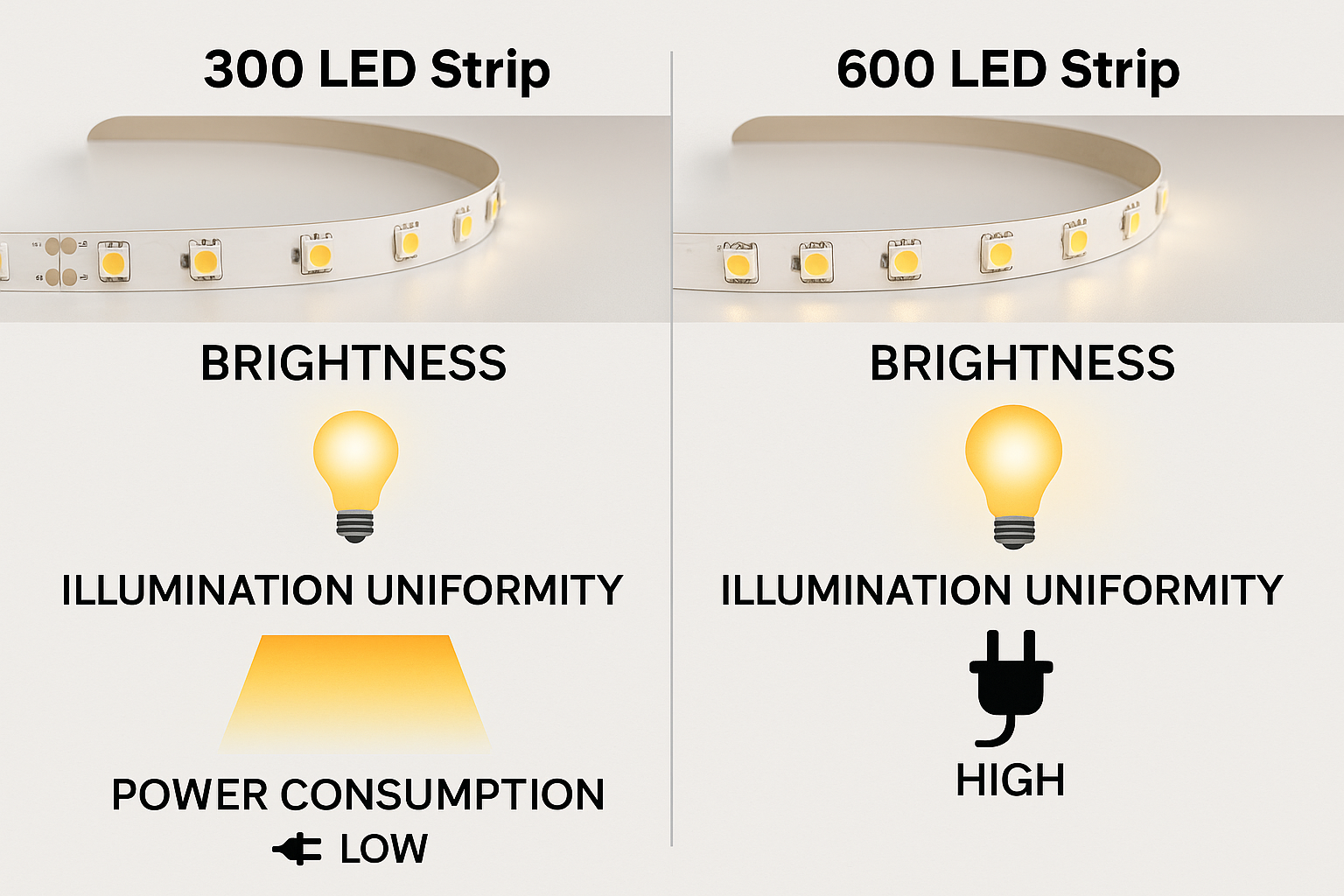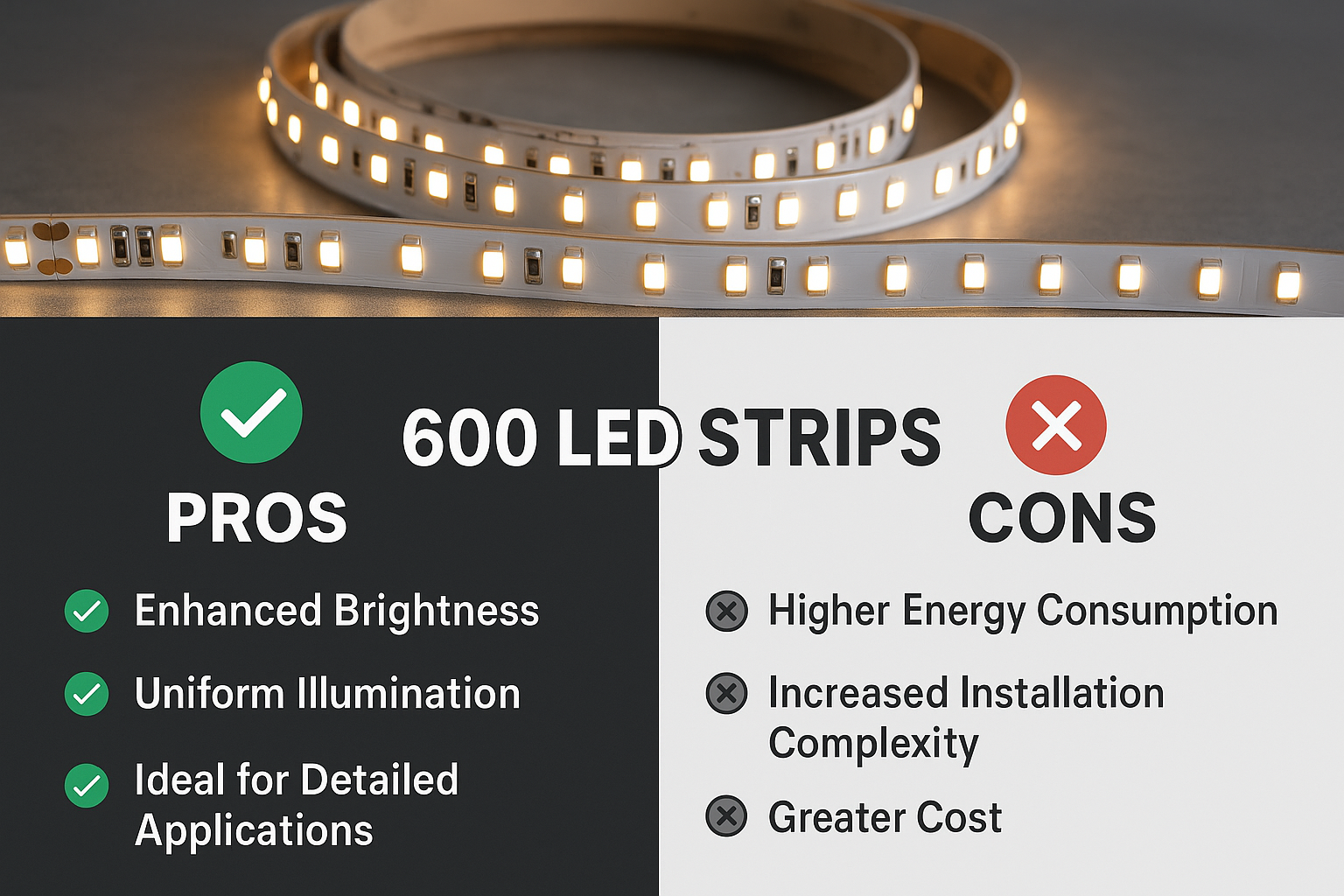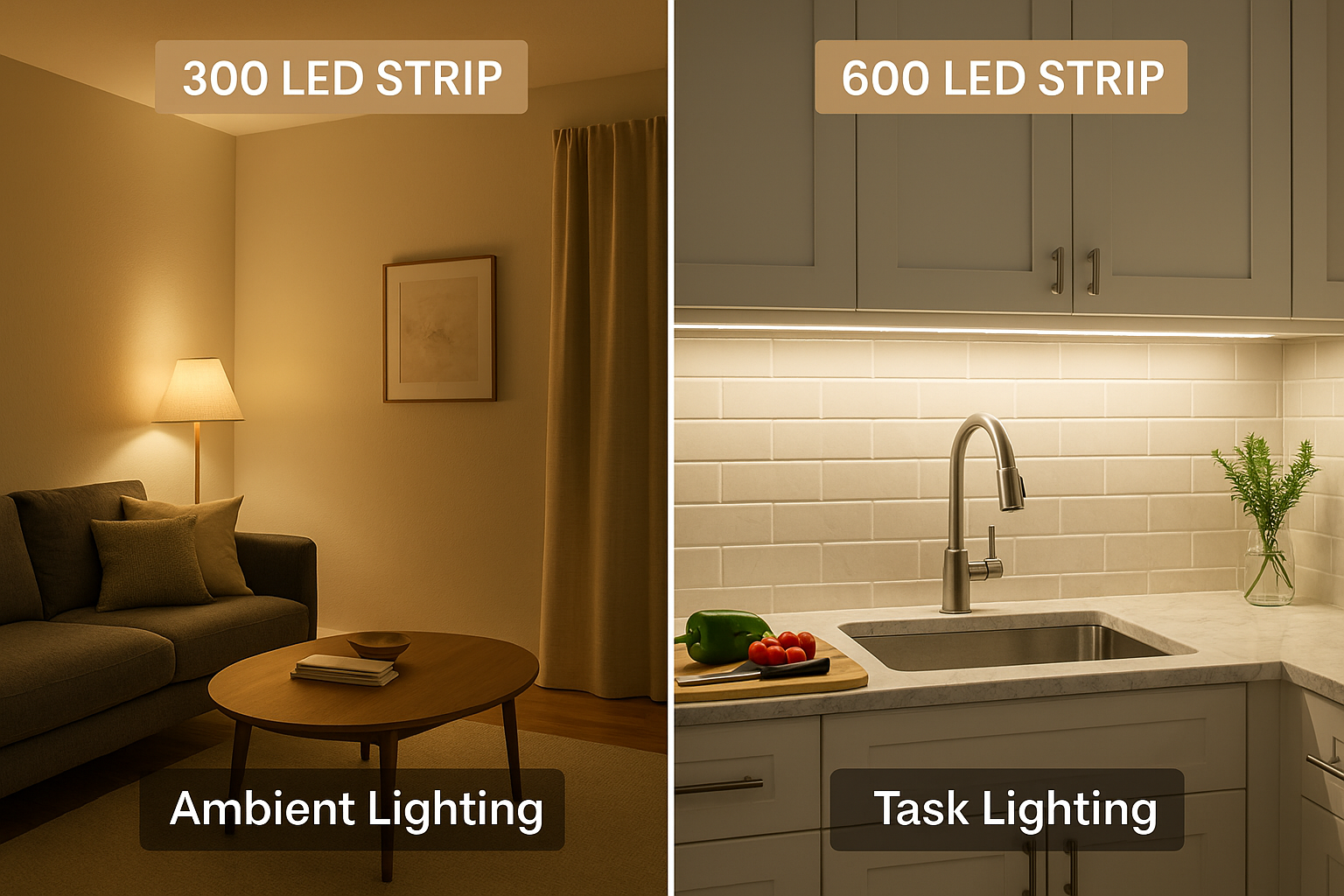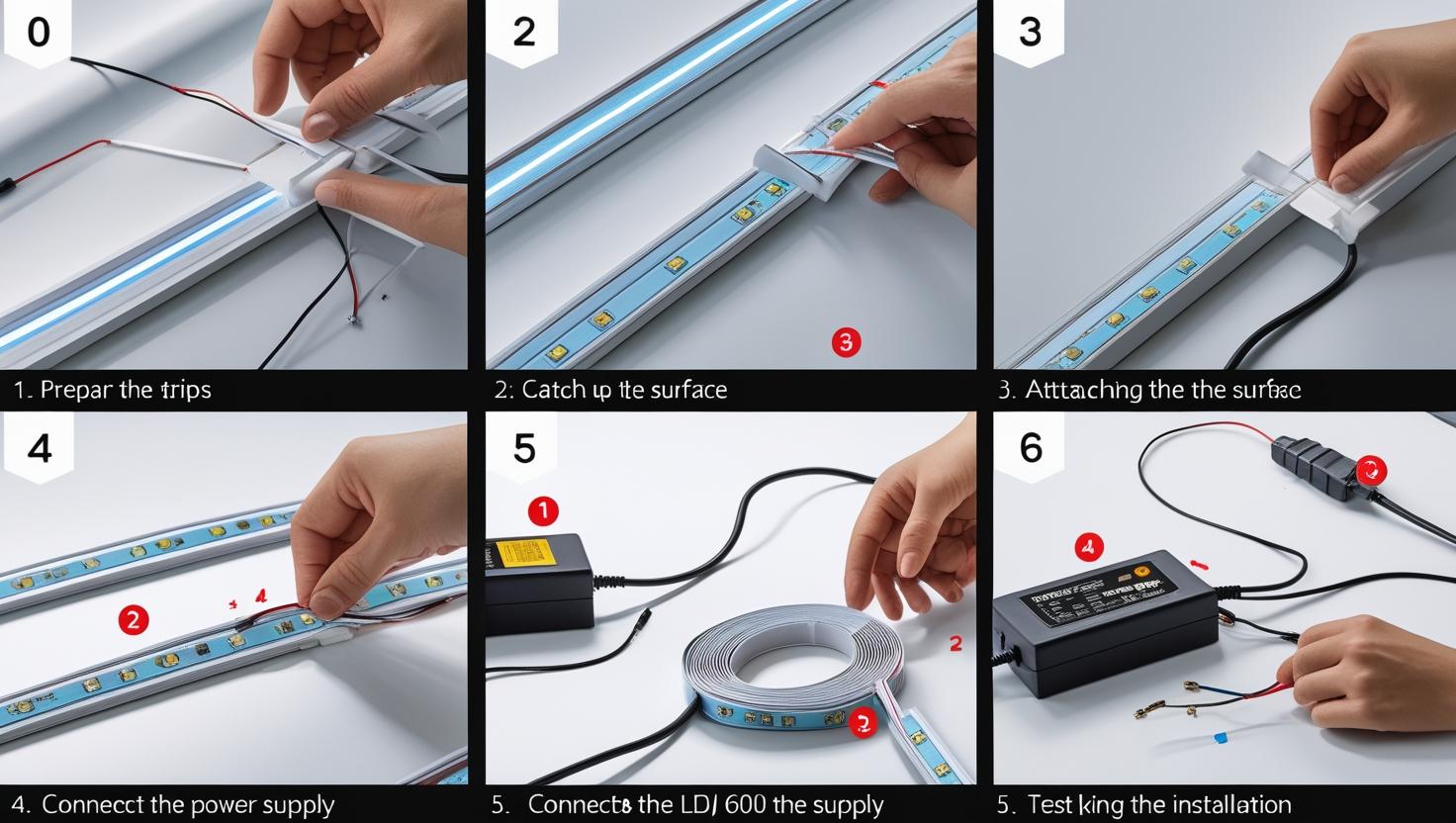“Choosing between 300 and 600 LED strips depends on your brightness requirements, installation area, and energy considerations. 600 LED strips offer higher brightness and better coverage, ideal for detailed or task lighting, while 300 LED strips are cost-effective, energy-efficient, and suitable for general decorative applications.”
Understanding LED Strip Density: 300 vs 600 LEDs
When selecting LED strips, understanding LED density—essentially the number of LEDs per strip—is crucial. Having personally worked with both 300 and 600 LED strips, I’d like to clearly explain their features, helping you choose the best fit for your project.
What Does 300 LED Strip Mean?
A “300 LED strip” typically refers to a strip containing 300 LEDs per 5 meters (about 60 LEDs per meter). From my experience, this density offers moderate brightness and is great for general ambient or decorative lighting, providing good coverage without excessive energy use.
What Does 600 LED Strip Mean?
A “600 LED strip,” meanwhile, doubles this density to approximately 120 LEDs per meter. In my installations, this higher density clearly delivers significantly brighter, more uniform illumination, ideal for detailed or task-focused lighting applications that require higher visibility and intensity.
An easy way to remember this: higher LED density (600 LEDs) generally translates to higher brightness and more uniform lighting coverage, perfect for detailed tasks or areas needing intense lighting.

Technical Differences Clearly Explained
Understanding the technical distinctions between 300 and 600 LED strips can significantly impact the effectiveness of your lighting project. From my personal experience, here’s a clear breakdown of the primary technical aspects you’ll want to consider.
Brightness & Lighting Performance
- 300 LED Strip:
Typically provides moderate brightness suitable for ambient, indirect, or decorative lighting. With fewer LEDs per meter, it offers softer illumination ideal for environments where intense brightness is unnecessary or even unwanted.
- 600 LED Strip:
With twice the number of LEDs per meter, 600 LED strips deliver significantly higher brightness and a more uniform illumination. They are particularly effective for detailed tasks, workspace lighting, or any setting requiring clear, even lighting distribution.
Power Consumption & Efficiency
- 300 LED Strip:
Consumes less energy and generates less heat due to fewer LEDs. It is generally more energy-efficient and easier to manage in terms of heat dissipation, especially in enclosed or indoor installations.
- 600 LED Strip:
Naturally consumes more power given its higher LED density, potentially requiring enhanced heat dissipation solutions or additional power supply planning for longer installations.
People often ask me, “How bright is a 600 LED strip compared to a 300 LED strip?” From my practical experience, a 600 LED strip generally provides approximately double the brightness and uniformity, ideal for scenarios demanding higher illumination.

Advantages and Disadvantages of 300 LED Strips
Having personally installed both 300 and 600 LED strips in various settings, I clearly understand the practical pros and cons of choosing 300 LED strips. Here’s my straightforward insight based on experience.
Pros of 300 LED Strips
- Cost-Efficient:
Typically less expensive than higher-density LED strips, making them ideal for budget-sensitive projects.
- Energy-Efficient:
Lower power consumption due to fewer LEDs means lower electricity costs over time.
- Easy Installation and Handling:
More straightforward to manage, easier to install, and simpler heat management requirements.
Cons of 300 LED Strips
- Limited Brightness:
Provides moderate brightness that may not be sufficient for detailed task lighting or areas requiring high-intensity illumination.
- Less Uniform Illumination:
Fewer LEDs per meter can result in less uniform lighting, particularly noticeable in detailed or close-up applications.
Many clients often ask, “What exactly does ‘300 LED’ mean?” It simply indicates that there are 300 LEDs per 5-meter strip, which equates to around 60 LEDs per meter—ideal for general ambient and decorative purposes.

Advantages and Disadvantages of 600 LED Strips
Drawing from my personal experiences installing LED lighting, I’d like to clearly present the practical advantages and disadvantages of using 600 LED strips. These insights will help you decide if higher-density LED strips fit your specific project requirements.
Pros of 600 LED Strips
- Enhanced Brightness:
With twice the LEDs compared to 300 LED strips, 600 LED strips deliver significantly greater brightness and illumination consistency, making them ideal for detailed or high-visibility areas.
- Uniform Illumination:
High LED density ensures a smoother, more even distribution of light, perfect for spaces needing clear and uniform lighting, such as workspaces or retail environments.
- Ideal for Detailed Applications:
Excellent choice for task-oriented projects, highlighting features clearly and effectively.
Cons of 600 LED Strips
- Higher Energy Consumption:
Increased LED density naturally results in greater energy use, potentially impacting your electricity costs.
- Increased Installation Complexity:
Higher power requirements may necessitate additional planning, including extra power sources and improved heat dissipation methods.
- Greater Cost:
Typically more expensive than lower-density strips, potentially affecting overall project budget.
People frequently inquire, “What’s considered a good LED strip density?” From my practical perspective, if detailed, task-focused lighting is essential, a 600 LED strip is clearly preferable. For ambient or decorative lighting, 300 LED strips often suffice.

Best Applications & Practical Scenarios
Having installed LED strips in various environments, I clearly understand how crucial it is to match the LED density with your project’s specific lighting needs. Here are my practical recommendations for choosing between 300 and 600 LED strips.
Ideal Uses for 300 LED Strips
- Residential Ambient Lighting:
Great for general living spaces, bedrooms, and indirect lighting scenarios where soft illumination is desired.
- Decorative & Accent Lighting:
Ideal for highlighting architectural features, furniture, and decorative installations where subtle lighting effects are sufficient.
- Budget-Friendly Projects:
Clearly beneficial when working within tighter budget constraints, balancing cost-effectiveness with sufficient lighting.
Ideal Uses for 600 LED Strips
- Detailed Task Lighting:
Clearly the best choice for kitchens, home offices, and commercial workspaces where bright, uniform, detailed lighting is necessary.
- Retail & Display Lighting:
Excellent for clearly showcasing products, displays, or artwork, providing consistent and vivid illumination.
- Professional or High-Visibility Areas:
Suitable for areas requiring consistent, bright lighting, such as offices, showrooms, or detailed architectural projects.
Clients often ask me, “Is higher LED density always better?” Based on my experience, it really depends on your lighting goals—600 LED strips offer superior brightness and clarity for detailed tasks, while 300 LED strips provide sufficient ambient and decorative lighting more affordably.

How to Choose Between 300 and 600 LED Strips
Choosing between 300 and 600 LED strips can seem tricky at first, but having installed both extensively, I’ve gained valuable insights to clearly help you make an informed decision. Here’s my straightforward guide highlighting key considerations and practical tips.
Key Factors to Consider
- Brightness Needs:
Clearly identify if your project requires high-intensity, detailed lighting (600 LEDs) or general, ambient illumination (300 LEDs).
- Application Area:
Consider whether you’re lighting task-oriented spaces (kitchens, workstations) or decorative areas (living rooms, accent lighting).
- Energy Efficiency & Power Supply:
Assess the available power supplies and energy usage implications—300 LED strips consume less power, while 600 LED strips require more substantial power supplies.
- Budget & Cost Efficiency:
Clearly balance project costs and desired illumination quality—300 LED strips are typically more budget-friendly, whereas 600 LED strips offer enhanced performance but at higher costs.
Common Mistakes and Practical Advice
- Ignoring Brightness Requirements:
A common mistake I’ve encountered is underestimating or overestimating brightness needs. Always clearly match LED strip density to your specific lighting goals.
- Overlooking Power and Heat Management:
Higher-density strips generate more heat and require better power supply management. Clearly plan for adequate heat dissipation and suitable power arrangements when choosing 600 LED strips.
- Choosing Solely Based on Cost:
Clearly evaluate long-term efficiency, brightness needs, and installation complexity beyond just the initial price difference.
If you’re still uncertain, this resource might clearly assist you further:
High Density vs Regular Density LED Strips – HitLights

brightness needs—clearly consider your desired illumination levels to avoid selecting inadequate LED density.
- Underestimating Power Requirements:
I’ve noticed many underestimate the additional power supply needed for 600 LED strips, resulting in installation complications. Clearly calculate the power needs upfront.
- Overlooking Installation Complexity:
Higher-density strips (600 LEDs) may require extra effort and heat management solutions compared to lower-density (300 LEDs) strips. Clearly plan accordingly.
A frequent question I receive is, “What is a good LED strip density for typical home projects?” From my experience, for general decorative and ambient lighting, 300 LED strips often provide sufficient brightness and ease of installation, while 600 LED strips are preferable for detailed or high-visibility areas.
External Link:
High Density vs Regular Density LED Strips – HitLights

Installation & Expert Recommendations
From my personal experience installing LED strips, I’ve found that the right preparation and clear guidelines significantly enhance performance, reliability, and safety. Here are straightforward installation tips, practical maintenance advice, and troubleshooting guidance for both 300 and 600 LED strip densities.
Step-by-Step Installation Guide
300 LED Strips Installation:
- Preparation:
Clearly measure and plan the exact installation area, ensuring surfaces are clean and smooth.
- Mounting:
Carefully peel adhesive backing and firmly attach strips, avoiding bends and twists.
- Connection & Testing:
Connect clearly to an appropriate power source, verifying correct polarity and power compatibility, then thoroughly test for consistent lighting.
600 LED Strips Installation:
- Detailed Planning:
Clearly identify placement considering additional power needs and potential heat dissipation requirements.
- Enhanced Mounting Techniques:
Use adhesive backing supplemented by mounting clips or aluminum channels clearly designed for improved heat management.
- Power & Heat Management:
Clearly provide sufficient power sources and plan for effective heat dissipation solutions to maintain optimal performance.
- Testing & Adjustments:
Power up cautiously, clearly inspect connections and brightness uniformity, and adjust as needed before finalizing installation.
Essential Maintenance Advice
- Regular Inspection:
Periodically inspect LED strips, ensuring adhesive strength and secure connections.
- Heat Dissipation:
Clearly prioritize proper heat management, especially for higher-density 600 LED strips, using aluminum channels or other cooling solutions.
- Cleaning:
Gently clean LED strips occasionally with a soft, dry cloth to maintain optimal brightness and efficiency.
Troubleshooting Common Issues
- Brightness Issues:
Clearly verify adequate power supply, connections, and check for voltage drop, especially with longer runs of 600 LED strips.
- Adhesion Problems:
Reinforce adhesion with additional clips or mounting channels, clearly preparing surfaces properly.
- Heat Management Concerns:
Ensure clear and effective heat dissipation measures are implemented to avoid overheating and performance degradation, particularly with higher-density strips.
A common question clients often ask is, “What common issues arise during installation?” From experience, typical challenges include insufficient power supply planning, inadequate heat dissipation for 600 LED strips, and incorrect polarity connections.

FAQs About 300 and 600 LED Strips
Here are clear answers to some of the most frequent questions I encounter about 300 and 600 LED strips, aimed at helping you confidently understand and address common concerns in your projects.
Is a 600 LED strip significantly brighter than a 300 LED strip?
Yes, a 600 LED strip provides approximately double the brightness and a more uniform illumination compared to a 300 LED strip. If your project demands intense, detailed lighting, choosing 600 LEDs is clearly advisable.
Does higher LED density consume more power?
Typically, yes. With more LEDs per meter, a 600 LED strip naturally consumes more power compared to a 300 LED strip. Clearly consider your power availability and plan accordingly for sufficient energy supply and heat dissipation.
Which LED strip density is better for residential lighting?
In my experience, 300 LED strips often provide sufficient brightness for general residential ambient or decorative lighting. However, for task-focused areas like kitchens, workspaces, or detailed accent lighting, 600 LED strips are clearly preferable.
Conclusion & Next Steps
Choosing between 300 and 600 LED strips clearly depends on your specific lighting goals. If you need general, cost-effective ambient or decorative lighting, 300 LED strips are a practical choice. For detailed, task-oriented environments requiring brighter, uniform illumination, 600 LED strips clearly provide superior performance.
Having shared my hands-on experience, I trust you now feel equipped and confident to make an informed decision tailored precisely to your project’s requirements.
Ready to select the perfect LED strip for your project?
Explore Elstar’s LED Lighting Solutions →









